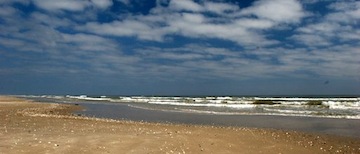340214-beach numbers.JPG

A beach on Matagorda Island. Credit: U.S. Fish & Wildlife Service
Beaches can be fragile. Wind and waves grind away at them, while human development can choke them off. And big storms can wash them away in hours. That leaves a question for the folks in charge of a damaged beach: In strictly economic terms, is it worth the cost to replace it? In the case of one small beach in Texas, the answer seems to be “yes.” A team of researchers found that the beach contributes much more to the economy than it would cost to replace it.
The researchers conducted a survey of beachgoers at a park near Matagorda, Texas. The park is a good way from any major city, so for much of the year it’s pretty quiet.
The researchers visited the park at different times of year — late summer, winter, and during spring break. They asked the beachgoers about their activities, how well they liked the beach and its facilities, and even whether they thought there was too much seaweed.
Most important, they asked how much money each group on the beach spent on its visit — travel costs, hotels, food, and so on. That added up to about $1200 per person. Multiplied by the estimated number of visitors, that’s somewhere between 2 million and 18 million dollars per year.
The Matagorda beach has never had to be restored, so the researchers looked at other beaches that have been. They estimated it would cost a bit more than $2 million to replace it.
So based on the numbers alone, they concluded that if anything ever happens to the beach, it would be well worth the cost to replace it.
This episode of Science and the Sea is made possible by Texas Sea Grant.

